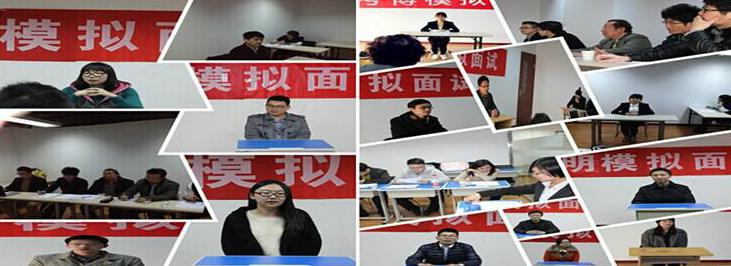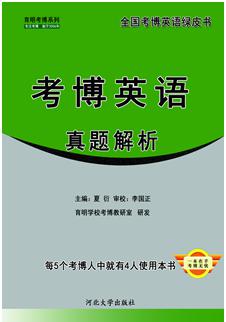资料来源:《考博英语真题解析》育明教育出品,北外夏衍教授主编
更多考博资讯、资料获取、考博课程QQ:547063862 电话:153-1148-1034
针对考博开设的辅导课程包括:专业课小班课程·一对一课程·视频班·定向保录班·复试保过班。根植育明学校深厚的高校资源,整合利用历届育明优秀学员的成功经验与高分资料,为每一位学员构建考博成功的基础保障,辅导学员人数及辅导成绩连续多年稳居第一。



Part I: Reading Comprehension (40%)
Directions: In this part for the test, there will be 5 passages for you to read. Each passage is followed by 4 questions or unfinished statement, and each question or unfinished statement is followed by four choices marked A, B, C and D. You are to decide on the best choice by blackening the corresponding letter on the ANSWER SHEET.
Passage 1
The changing profile of a city in the United States is apparent in the shifting definitions used by the United States Bureau of the Census. In 1870 the census official distinguished the nation's urban from its "rural" population for the first time. "Urban population" was defined as persons living in towns of 8,000 inhabitants or more. But after 1900 it meant persons living in incorporated places having 2,500 or more inhabitants.
Then in 1950 the Census Bureau radically changed its definition of "urban" to account of the new vagueness of city boundaries. In addition to persons living incorporated units of 2,500 or more, the census now included those who lived in unincorporated units of that size, and also all persons living in the densely settled urban fringe, including both incorporated and unincorporated areas located around cities of 50,000 inhabitants or more. Each such unit, conceived as an integrated economic and social unit with a large population nucleus was named a Standard Metropolitan Statistical Area (SMSA).
Each SMSA would contain at least one central city with 50,000 inhabitants or more or two cities having shared boundaries and constituting, for general economic and social purposes, a single community with a combined population of at least 50,000, the smaller of which must have a population of at least 15,000. Such an area included the country in which the central city is located, and adjacent countries that are found to be metropolitan in character arid economically and socially integrated with the country of the central city. By 1970, about two-thirds of the population of the United States was living in these urbanized areas, and of that figure more than half were living outside the central cities
While the Census Bureau and the United States government used the term SMSA (by 1969 there were 233 of them), social scientists were also using new term to describe the elusive vaguely defined areas reaching out from what used to be simple "town" and "cities". A host of terms came into use: "metropolitan regions", "polynucleated population groups", ''conurbations", "metropolitan clusters", "megalopolises", and so on.
1. What does the passage mainly discuss?
A. How cities in the United States began and developed?
B. Solutions to overcrowding in cities
C. The changing definition of an urban area
D. How the United States Census Bureau conducts a census?
2. Prior to 1900, how many inhabitants would a town has to have before being defined as urban?
A | 2,500 | B | 8,000 | C | 15,000 | D | 50,000 |
3. According to the passage, why did the Census Bureau revise the definition of urban in 1950?
A. City borders had become less distinct.
B. Cities had undergone radical social change.
C. Elected officials could not agree on an acceptable definition.
D. New businesses had relocated to larger cities.
4. Which of the following is NOT true of an SMSA?
A. It has a population of at least 50,000.
B. It can include a city's outlying regions.
C. It can include unincorporated regions.
D. it consists of at least two cities.
Passage 2
The concept of obtaining fresh water from icebergs that are towed to populated areas and arid regions of the world was once treated as a joke more appropriate to cartoons than real life. But now it is being considered quite seriously by many nation especially since scientists have warned that the human race will outgrow its flesh was supply faster than it runs out of food.
Glaciers are as a possible source of fresh water that has been overlooked recently. Three-quarters of the Earth's fresh water supply is still tied up in glacial ice, reservoir of untapped fresh water so immense that it could sustain all the rivers of the world for 1,000 years. Floating on the oceans every year are 7,659 trillion metric tons ice encased in 10,000 icebergs that break away from the polar ice caps, more than ninety percent of them from Antarctica.
Huge glaciers that stretch over the shallow continental shelf give birth to icebergs throughout the year. Icebergs are not like sea ice, which is formed when the sea itself freezes; rather they are formed entirely on land, breaking off when glaciers spread over the sea. As they drift away from the Polar region, icebergs sometimes move mysteriously in a direction opposite to the wind, pulled by subsurface currents. Because they melt more slowly than smaller pieces of ice, icebergs have been known to drift as far north as 35 degrees south of the equator in the Atlantic Ocean. To corral them and steer them to parts of the world where they are needed would not be too difficult.
The difficulty arises in other technical matters, such as the prevention of rapid melting in warmer climates and the funneling of fresh water to shore in great volume. But even if the icebergs lost half of their volume, the water they could provide would be far cheaper than that produced by desalination, or removing salt from water.
5. What is the main topic of the passage?
A. The movement of glaciers
B. Icebergs as a source of fresh water
C. Future water shortages
D. The future of the world's rivers
6. How ale icebergs formed?
A. They bread off from glaciers.
B. Seawater freezes.
C. Rivers freeze.
D. Small pieces of flowing ice converge
7. With which of the following ideas would the author be likely to agree?
A. Towing icebergs to dry areas is economically possible.
B. Desalination of water is the best way to obtain drinking water.
C. Using water from icebergs is a very short-term solution to water shortages.
D. Icebergs could not be towed very far before they would melt.
8. It can be inferred from the passage that most icebergs ________.
A. become part of glaciers
B. drill toward the polar region
C. move in whichever direction the wind is blowing
D. melt in the oceans
Passage 3
There are two ways to create colors in a photograph. One method, called additive, sits with three basic colors and adds them together to produce some other color. The second method, called subtractive, starts with white light (a mixture of all colors in the spectrum) by taking away some or all other colors, leaves the one desired.
In the additive method, separate colored lights combine to produce various other colors. The three additive primary colors are green, red, and blue (each proving about one-third the wavelengths in the total spectrums). Mixed in varying proportions, they can produce all colors. Green and red light mix to produce yellow, red and blue light mix to produce magenta, green and blue mix to produce cyan. When equal parts of all three of these primary-colored beams of light overlap, the mixture appears white to the eye.
In the subtractive process colors are produced when dye (as in paint or color photograph materials) absorbs some wavelengths and so passes on only part of the spectra. The subtractive primaries are cyan (a bluish green), magenta (a purplish pink), and yellow; these are the pigments or dyes that absorb red, green, and blue wavelengths, respectively, thus subtracting them into white light. These dye colors are the complementary colors to the three additive primaries of red, green, and blue. Properly combined, the subtractive primaries can absorb all colors of light, producing black. But, mixed in varying proportions, they too can produce any color in the spectrum.
Whether a particular color is obtained by adding colored lights together or by subtracting, some light from the total spectrum, the result looks the same to the eye. The additive process was employed for early color photography. But the subtractive method, while requiring complex chemical techniques, has turned out to be more practical and is the basis of all modern color films.
9. Which of the following is closest in meaning to the phrase "passes on" as used in paragraph 3?
A | Judges | B | Let through | C | Dies | D | Goes over |
10. Which of the following is NOT a pair of additive, and subtractive primary colors?
A | Yellow and blue | B | Magenta and green | C | Black and white | D | Cyan and red |
11. What explanation is given for the use of the subtractive method in modem color films?
A. Subtractive colors are more realistic.
B. The subtractive process is more efficient.
C. Additive chemical techniques are too complex.
D. The additive process is still being developed.
12. How is the passage organized?
A. The reasons for a choice are explained in depth.
B. A general statement is justified by a series of historical examples.
C. Two basic causes are compared.
D. Related processes are described one after the other.
Passage 4
The idea of humanoid robots is not new. They have been part of the imaginative landscape ever since Karl Capek, a Czech writer, first dreamed them up for his 1921 play Possum's Universal Robots (The word robot comes from the Czech word “drudgery”, Roberta.) Since then, Hollywood has produced countless variations on to theme, from the sultry False Mona in Fritz Lang's silent masterpiece Metropolis to the withering C3PO in Star Wars and the ruthless assassin of Terminator. Humanoid robots have walked into our collective subconscious coloring our views of the future.
But now Japan's industrial giants are spending billions of yen to make such robots reality. Their new humanoids represent impressive feats of engineering: when Honda introduced Asimo, a four-foot robot that had been in development for some 15 years walked so fluidly that its white, articulated exterior seemed to conceal a human. Honda continues to make the machine faster, friendlier and more agile. Last October, when Asimo was inducted into the Robot Hall of Fame in Pittsburgh, it walked on to the stag and accepted its own plaque.
At two and a half feet tall, Sony's QRIO is smaller and more toy-like than Asimo. It walks, understands small number of voice commands, and can navigate on its own. If it falls over, it gets up and resumes where it left off. It can even connect senselessly to the interpreter and broadcast what its camera eyes can see. In 2003, Sony demonstrated an upgraded QRIO Rat could run. Honda responded last December win a version of Asimo that runs at twice the speed.
In 2004, Toyota joined the fray win its own family of robots, called Partners, one of which is a four-foot humanoid that plays the trumpet. Its fingers work the instrument valves, and it has mechanical lungs and artificial lips. Toyota hopes to over commercial version of the robot by 2010. This month, 50 Partner robots will act guides at Expo 2005 in Aichi, Japan.
Despite their sudden proliferation, however, humanoids are still a mechanic minority. Most of the world's robots are faceless, footless and mute. They are bolted the floors of factories, stamping out car parts or welding pieces of metal, making more machines. According to the United Nations, business orders for industrial robots jumped 18% in the first half of 2004. They may soon be outnumbered by domestic robots, such as self-navigating vacuum cleaners, lawn mowers and window washers, which at selling fast. But neither industrial nor domestic robots are humanoid.
13. In paragraph 1 the author introduces his topic by relating ________.
A. the idea of humanoid robots
B. Karl Capek's creation of robots
C. Hollywood's production of robot films
D. the origin of and popular movies about robots
14. Sony's QRIO could perform all the following tasks EXCEPT ________.
A. walking earners freely
B. understanding some words uttered by people
C. finding its way
D. continuing walking after it stumbles
15. From the passage we may infer that Toyota's Partner ________.
A. is much better than any other robots
B. is no more than a mechanic device
C. may be put into mass production
D. may speak like man
16. Judging from the context, this passage is probably written ________.
A | in 2004 | B | in 2005 | C | between 2003-2004 | D | between 2004-2005 |
参考答案:
1. 选C。文章讲的是美国历史上城市定义的变化。
2. 选B。从原文第一段可知,1870到1900年,城市人口定义为拥有8000及以上常住人口地区的居住人口。
3. 选A。从原文take account of the new vagueness of city boundaries以及social scientists were also using new term to describe the elusive vaguely defined areas reaching out from what used to be simple "town" and "cities"可知,随着社会发展,城市的概念越来越模糊,旧的定义方法已不能满足需要。
4. 选D。第三段提到,每个标准城市统计区至少有一座中心城市及50,000及以上常住人口(one central city with 50,000 inhabitants or more)或是共同边界及共同建制的两座城市(two cities having shared boundaries and constituting),因此排除A、B、C。
5. 选B。全文主要是讨论将冰山作为淡水源。
6. 选A。从第三段首句Huge glaciers that stretch over the shallow continental shelf give birth to icebergs throughout the year可知,冰山来自于巨型冰川。
7. 选A。从原文首句及第三段最后一句可知,作者认为将冰山运到人口稠密地区并非空谈。文中提出,因为储量庞大,且冰山不易溶化,其作为淡水资源是很有潜力的,排除C、D。文中并未提及将海水脱盐作为解决淡水资源问题的手段,排除B。
8. 选D。从文中可推出虽然冰山不易溶化,但最终还是要溶在海中。冰山源自极地冰川断裂,而非最后形成冰川,排除A、B。文中也提到,冰川漂浮方向时常与风向相反,排除C。
9. 选B。pass on此处指让……通过。
10. 选C。根据文章内容和上题,加色法三原色为红、绿、蓝,减色法三原色为青色、洋红、黄色,没有黑色与白色,因此C项正确。